Newfound Woodworks of Bristol, New Hampshire, specializes in strip-built canoes and kayaks. Their Sea Wolf kayak, designed by Hans Friedel of Sweden, has stability that would put novice paddlers at ease and provide a reassuring platform for fishing or photography. For more ambitious endeavors, it is the company’s “best expedition-style kayak.”
The Sea Wolf can be built from plans or a kit.
For scratch builders, the plans set consists of eight sheets. Six are printed with full-sized patterns for the 16 station molds, bow and stern end-forms, hatch spacers and lips, and the two bulkheads. The remaining two pages are overall views, one indicating the placement of the molds on the strongback, the other showing the placement of all the fittings on the finished kayak. Included with the plans is a 30-page manual of detailed step-by-step instructions illustrated with color photographs.
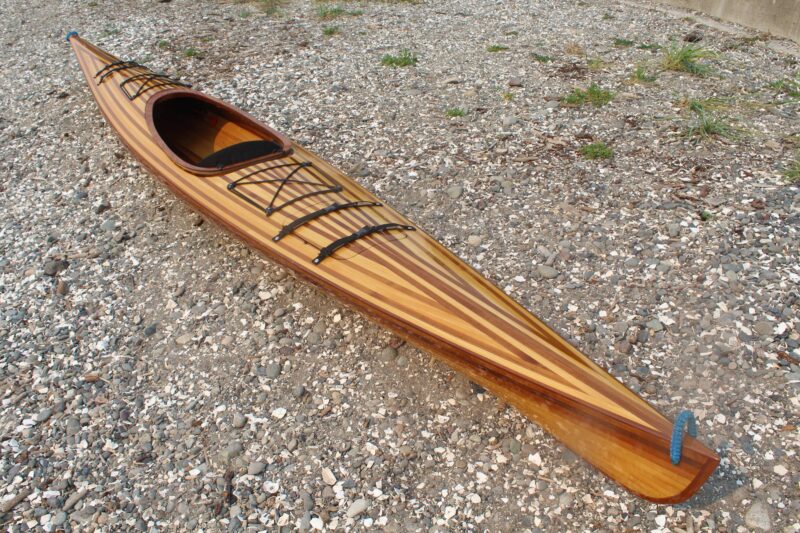 Christopher Cunningham
Christopher CunninghamThe Sea Wolf has a generous volume both for larger paddlers and cruising cargo. The low profile of the recessed coaming keeps it from interfering with paddling and rescue techniques.
The kit includes all the materials for building and outfitting the Sea Wolf kayak, from the molds and a precut sectional strongback, to cedar strips and epoxy, to deck hardware and cockpit accommodations: seat, backband, and foot braces. The printed plans for the kit are a five-page set that includes assembly instructions for the interlocking pieces of the strongback. For those new to such a project, an optional Pre-Kit package has a booklet describing the building process, and DVDs on strip-building and fiberglassing.
The Sea Wolf I paddled was built by Newfound Woodworks as a demo kayak, and the workmanship is first rate. While the bead-and-cove strips fit neatly together (as I expected, without gaps), there are many joints between the deck strips that surely required careful work to make them tight. Throughout the kayak, each strip showed tiny dark marks where staples had secured them to the molds while the glue in the seams cured. Using staples speeds the building process as there is no limit to the number of strips that can be applied in one session. The resulting staple marks can be avoided by using the grooves milled in the kit’s molds. These make it possible to use spring clamps and tape to hold the strips, but fewer strips can be applied during each gluing session.
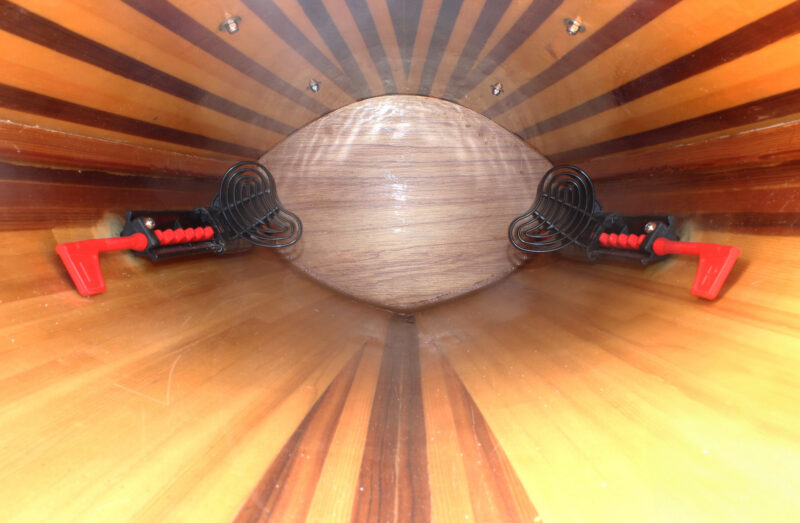 Christopher Cunningham
Christopher CunninghamThe forward end of the cockpit has plenty of room for size 13 (even size 14) booties. SEA-LECT Designs foot braces provide a solid connection with the kayak.
The bulkheads at each end of the cockpit are plywood and are fixed into the hull with thickened epoxy fillets and to the deck with an adhesive caulking. The hatches are cut from the deck, a task that must be done accurately the first time: there is no straightening the sides or smoothing the corner curves later. The hatch openings are large enough for loading good-sized dry bags without having to squeeze them through. Even an uncompressed sleeping bag would be easy to stow. A soft neoprene gasket seals each hatch, and its cover is held down by a pair of straps with buckles and blocks attached on the underside to apply direct pressure to the cover’s sides. The resulting seal is nearly watertight. The rear compartment took on only about half a cup of water during my several capsizes, rolls, and self-rescues. The forward compartment took on more as a block was missing from beneath one of the straps.
There are rectangles of bungees laced through low-profile fittings through-bolted on deck. These provide places to stow gear needed while underway and also serve as a means of anchoring a paddle blade during a paddle-float-outrigger self-rescue. I would also add non-stretch deck lines on the ends of the kayak to serve as handholds for self- and assisted rescues.
The ends do have grab loops made in the manner of square-knot paracord bracelets. They offer a comfortable grip and don’t make the annoying noise that hard plastic toggles do.
Weighing just 44 lbs, the Sea Wolf is light enough for a solo carry and for lifting to roof racks. The coaming, without protruding thigh-brace flanges, has nothing to make a shoulder-carry uncomfortable.
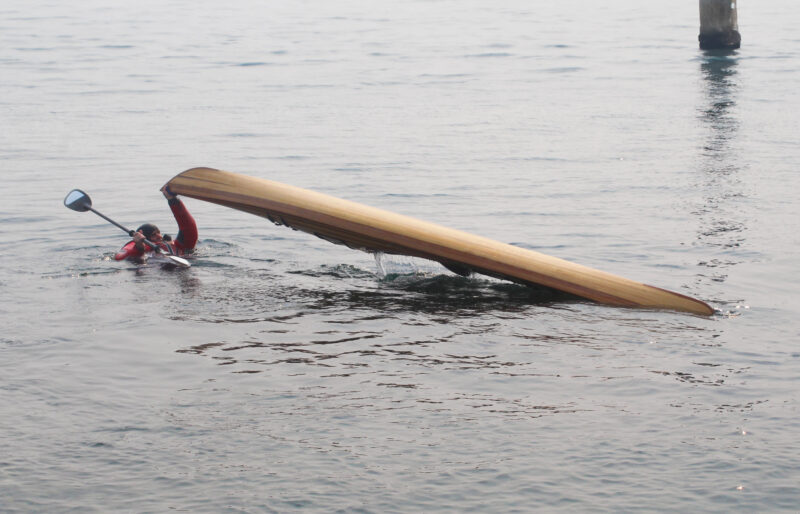 Alan Mann
Alan MannThe Sea Wolf is light enough that the bow can be easily lifted to drain the cockpit after a capsize and a wet exit.
Getting aboard the Sea Wolf seat-first is easy. I am 6′ tall and the cockpit opening has plenty of room—both in its length and in the broad curve at its forward end—to bring my legs in after I am planted on the seat. The foot braces, made of fiberglass-reinforced nylon by SEA-LECT designs, are adjustable over a range of 10″ and are hand-locked in place with a twist of a rod that extends aft from each brace fixture. The pedals are non-slip, have a large surface area for comfort, and provide a solid connection with the kayak. At the forward end of the cockpit there is enough space between the foot braces and the deck for my size-13 feet in neoprene booties.
The molded plastic seat has deep, comfortable contours and its integral hip braces kept me centered in the cockpit while edging for turns or rolling. The fabric-faced compressed-foam backband spans the distance between the seat and the back of the coaming. It provides excellent lower-back support and didn’t hamper my torso rotation while paddling or rolling.
The cockpit coaming is recessed to lower its profile and keep it at deck level. Its aft end doesn’t impede re-entry maneuvers, and its forward end is well below my knuckles when I’m paddling.
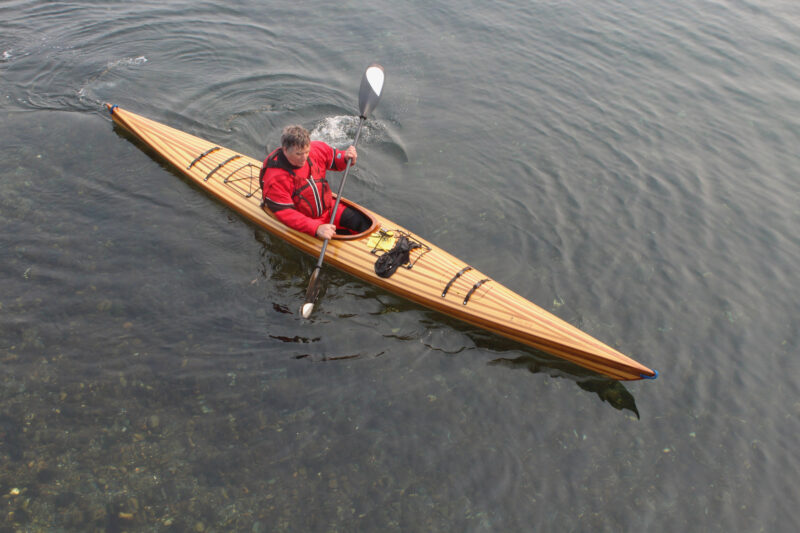 Alan Mann
Alan MannWhile the plans and the kit for the Sea Wolf include thigh-brace flanges at the forward end of the cockpit coaming, their absence in the test kayak didn’t compromise edging or rolling.
The Sea Wolf’s initial stability put me at ease while I had my hands off the paddle to take notes or check my GPS-measured speed. The kayak could easily lend itself to fishing and photography. The secondary stability was excellent. I could edge the kayak to get the coaming to the water’s edge before the stability dropped off. This was without cargo aboard; the weight of any gear in the cargo compartments would make the stability even better.
The speed was also very good. At a relaxed paddling pace, I averaged 4.5 knots while at an aerobic-exercise pace I could hold 5.8 knots. In a short sprint I made 6.7 knots, an excellent top end for a cruising kayak.
Tracking was outstanding at any speed. The Sea Wolf went where I aimed it, and the bow yawed very little between strokes. Turning at speed was made easier by edging, although the bow would swing around during the stroke and not continue to carve through a turn between strokes made on the outside of the turn. Achieving a 360° spin took 25 strokes, pulling on one side and backing on the other. That is on the high side for a kayak of this size and type and confirms that the Sea Wolf was designed to hold a course while making long passages.
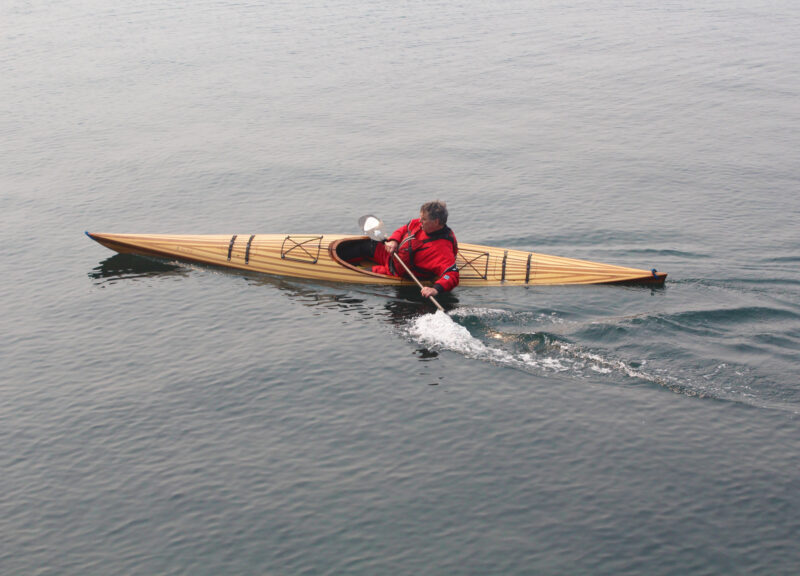 Alan Mann
Alan MannStability, both initial and secondary, are strong points for the Sea Wolf, and bring confidence to aggressive maneuvers.
In self-rescue techniques, the Sea Wolf performed well. To do a wet exit after a capsize, I could easily drop out of the cockpit. I didn’t have to grip the coaming with my hands to push myself aft in order to free my legs. After the capsize I swam to the bow and lifted it to drain the cockpit. The aft bulkhead is close to the aft end of the cockpit so most of the water drained before the kayak turned upright. The cowboy self-rescue—climbing over the stern of the kayak, crawling forward, and dropping seat-first into the cockpit—went well with only a little bracing with the paddle to steady myself as I brought my legs aboard. The Sea Wolf’s stability kept me upright throughout the process.
There was no spray skirt available for my sea trials, but I can roll a sea kayak easily without one and had no trouble rolling the Sea Wolf. The seat and hip braces kept me centered and the backband didn’t restrict my layback. While the plans indicate knee braces as part of the coaming structure, this Sea Wolf was built without them, but the recess for the coaming creates a contour that allowed me to keep my legs well braced. Even for a re-entry and roll—where I capsize, exit the kayak, duck underwater, and slip back aboard upside down—I was able to get locked in quickly and roll up without difficulty.
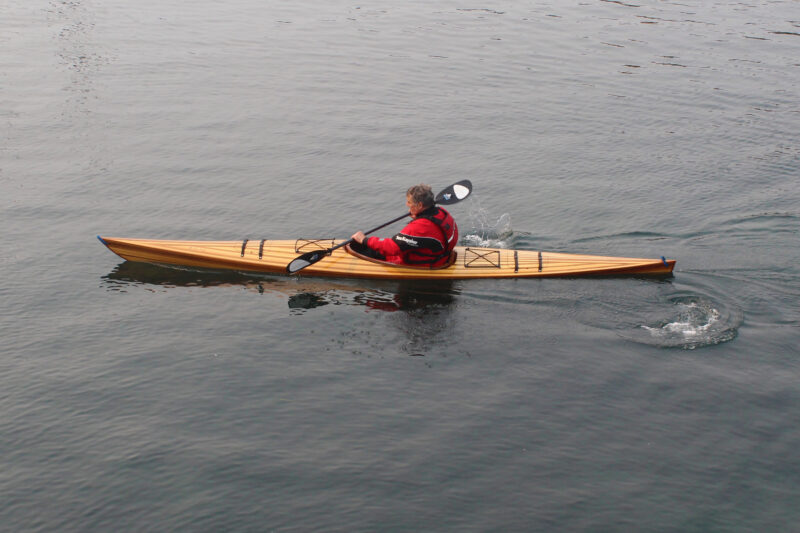 Alan Mann
Alan MannThe Sea Wolf’s strong tracking and easily driven hull would be well suited for quick passagemaking on coastal cruises.
When I paddled the Sea Wolf, the conditions were calm, so I couldn’t assess its performance in wind and waves. However, judging by the photos taken of the kayak with me aboard, there is plenty of volume and freeboard forward to take on waves without having them wash over the deck. In a crosswind, the shape and depth of the stern below the waterline would have the effect of a skeg and minimize weathercocking.
Newfound Woodworks notes that “the extra capacity that this design has can also facilitate gear storage for extended trips,” and a photo of Alan Mann, one of the co-owners of Newfound Woodworks, shows the Sea Wolf supporting his 6′ 5″, 300-lb frame with plenty of freeboard to spare. The kayak could easily manage my weight with upwards of 100 lbs of cruising gear and supplies aboard.
I was impressed with the performance of the Sea Wolf. For a kayak with generous carrying capacity and first-rate stability, it has surprisingly good speed. I think the pleasure I took in paddling it in mild conditions would extend into multi-day, even weeklong, cruising.![]()
Christopher Cunningham is Small Boat’s editor-at-large.
Sea Wolf Particulars
Length: 17′
Beam: 23 3⁄4″
Capacity: 300 lbs
Draft: 4 7⁄8″
Waterline length: 16′ 3″
Waterline beam: 23 1⁄2″
Weight: 44 lbs
Newfound Woodworks offers Sea Wolf plans for $95, the kit for $3,180, and a Pre-Kit for $65.
Is there a boat you’d like to know more about? Have you built one that you think other Small Boats readers would enjoy? Please email us your suggestions.



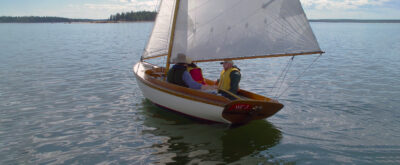
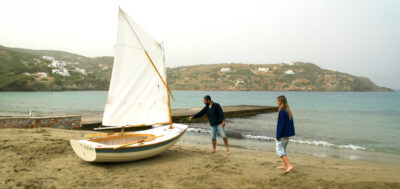

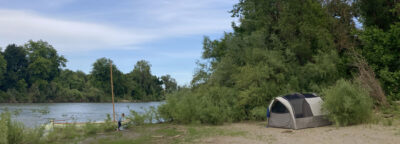
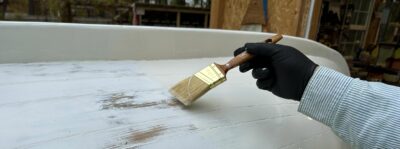
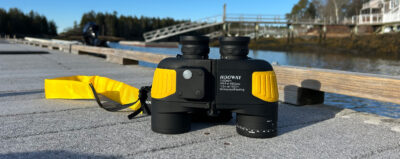
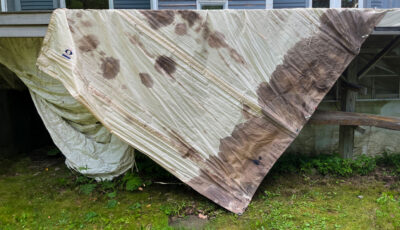
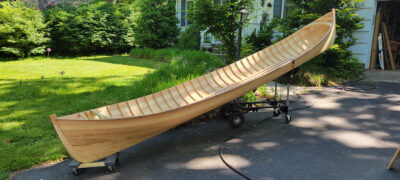
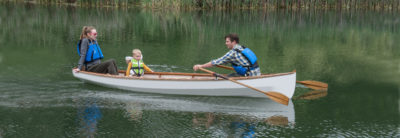
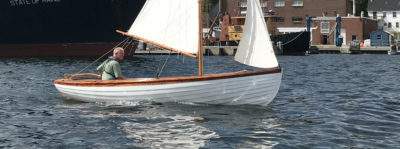
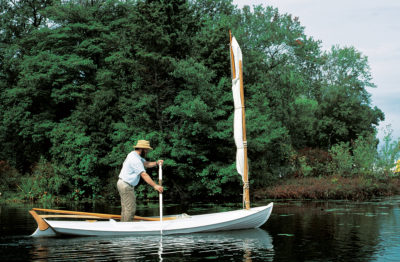
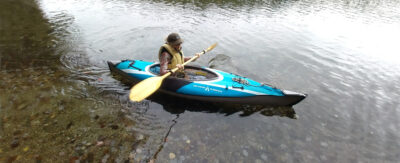
Join The Conversation
We welcome your comments about this article. If you’d like to include a photo or a video with your comment, please email the file or link.